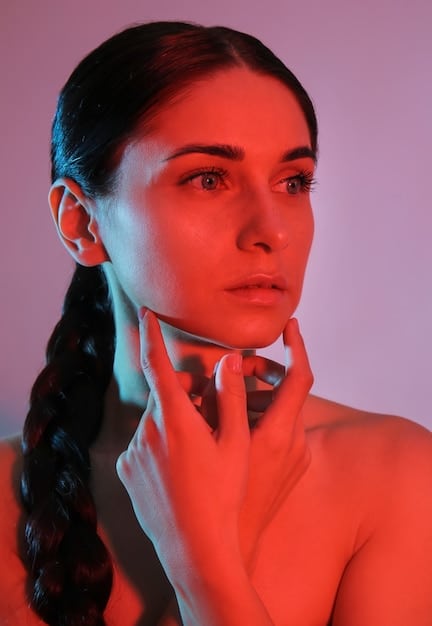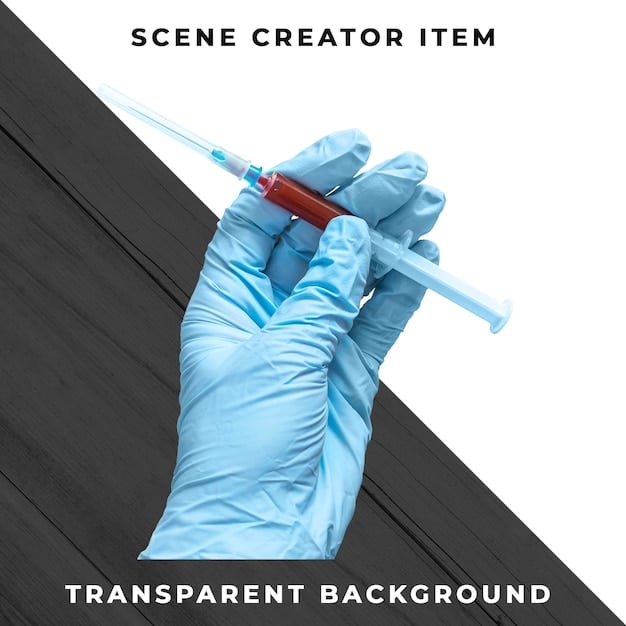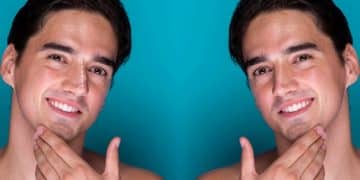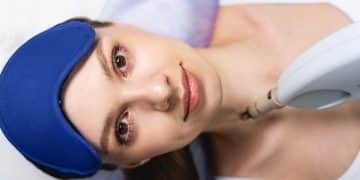Choosing a Qualified Facial Aesthetics Practitioner: 7 Key Questions

Choosing a qualified facial aesthetics practitioner involves asking essential questions about their qualifications, experience, training, and the specific procedures they offer to ensure you receive safe and effective treatment tailored to your needs.
Embarking on a journey to enhance your natural beauty through facial aesthetics? How to choose a qualified facial aesthetics practitioner: 7 essential questions to ask is the guide you need to ensure your safety, satisfaction, and stunning results.
Understanding the Importance of Qualification in Facial Aesthetics
When considering facial aesthetic treatments, the qualifications of the practitioner are paramount. It’s not just about enhancing appearance; it’s about ensuring your health and safety are in the most capable hands. Understanding the importance of proper training and expertise in this field can significantly reduce the risks associated with these procedures.
Navigating the world of facial aesthetics can be daunting, with numerous practitioners offering various services. However, not all practitioners possess the same level of skill, knowledge, or commitment to patient safety. Before undergoing any treatment, it’s essential to verify the qualifications and credentials of the individual performing the procedure.
Why Proper Training Matters
Facial aesthetic procedures involve precise techniques and a deep understanding of facial anatomy. Proper training equips practitioners with the necessary skills to administer treatments safely and effectively. This includes knowing how to handle complications, manage adverse reactions, and tailor treatments to individual patient needs.
The Risks of Unqualified Practitioners
Choosing an unqualified practitioner can lead to a range of complications, from minor side effects like bruising and swelling to more serious issues such as infections, nerve damage, and unsatisfactory results. Additionally, unqualified practitioners may not have adequate insurance coverage, leaving patients without recourse in case of complications.
- Verify the practitioner’s qualifications and credentials.
- Inquire about their training and experience in the specific procedure you’re interested in.
- Ask about their approach to patient safety and management of potential complications.

Choosing a qualified facial aesthetics practitioner is a decision that should be approached with careful consideration. By prioritizing qualifications and expertise, patients can minimize the risks and maximize the potential for achieving their desired aesthetic outcomes safely and effectively.
Question 1: What are Your Qualifications and Credentials?
The first and perhaps most important question to ask a facial aesthetics practitioner is about their qualifications and credentials. This information will provide insight into their training, expertise, and adherence to industry standards.
It’s essential to remember that facial aesthetic treatments are medical procedures and should be performed by qualified healthcare professionals. Don’t hesitate to ask for specific details about their qualifications and verify their credentials with the relevant regulatory bodies.
Medical Background and Training
Ideally, your practitioner should have a medical background as a doctor, nurse, or dentist. They should also have completed specialized training in facial aesthetics procedures. Look for certifications from reputable training programs and courses.
Registration and Licensing
Ensure that the practitioner is registered with the appropriate regulatory body in your country or region. This registration indicates that they have met the required standards of education, training, and competence to practice facial aesthetics safely.
- Request to see copies of their qualifications and certifications.
- Verify their registration with the relevant regulatory body.
- Ask about their ongoing professional development activities.
Inquiring about a practitioner’s background sets the stage for a transparent and informed decision-making process. It’s your right to know the qualifications of the person providing your care.
Question 2: How Much Experience Do You Have with This Specific Procedure?
Experience is a crucial factor to consider when selecting a facial aesthetics practitioner. While qualifications provide a foundation of knowledge and training, experience translates into practical skills and expertise in performing specific procedures.
It’s essential to inquire about the practitioner’s experience with the specific treatment you’re interested in. Different procedures require different techniques and levels of expertise. Choosing a practitioner who has extensive experience with your desired treatment can increase the likelihood of achieving satisfactory results and minimizing potential complications.
The Value of Hands-On Experience
Hands-on experience allows practitioners to refine their skills, develop their techniques, and learn how to adapt to different patient needs and anatomical variations. Experienced practitioners are also better equipped to manage potential complications and adverse reactions effectively.
Assessing Their Portfolio
Ask the practitioner how many times they have performed the procedure and ask to see “before and after” photos of their patients. Reviewing their portfolio provides valuable insights into their aesthetic style, skill level, and ability to achieve desired outcomes.
- Ask the practitioner how many times they have performed the procedure.
- Request to see “before and after” photos of their patients.
- Inquire about their approach to personalized treatment planning.
The more experience a practitioner has with a specific procedure, the more confident you can be in their ability to deliver safe, effective, and aesthetically pleasing results.
Question 3: Can I See Before-and-After Photos of Your Patients?
Reviewing before-and-after photos is an essential step in evaluating the suitability of a practitioner for your desired facial aesthetics procedure. These images offer tangible proof of the practitioner’s skills, aesthetic sense, and ability to achieve natural-looking results.
When reviewing before-and-after photos, pay attention to the overall aesthetic outcome, symmetry, and naturalness of the results. Look for consistent results across a variety of patients and consider whether the results align with your own aesthetic preferences.
Evaluating Aesthetic Style and Results
Before-and-after photos provide valuable insights into the practitioner’s aesthetic style and their ability to achieve desired outcomes. Look for examples that closely match your own aesthetic goals and preferences.
Understanding Realistic Expectations
Before-and-after photos can also help you develop realistic expectations about the potential results of your treatment. It’s essential to understand that individual results may vary and that not all outcomes can be guaranteed.

- Ask to see a variety of before-and-after photos to assess the practitioner’s versatility.
- Pay attention to the consistency and naturalness of the results.
- Discuss your own aesthetic goals and expectations with the practitioner.
By carefully reviewing before-and-after photos, you can gain valuable insights into the practitioner’s skills, aesthetic style, and ability to deliver results that align with your expectations.
Question 4: What Training Have You Had in Facial Anatomy?
A thorough understanding of facial anatomy is essential for any practitioner performing facial aesthetics procedures. Knowledge of the underlying structures, including muscles, nerves, and blood vessels, is crucial for ensuring patient safety and achieving optimal results.
Practitioners who possess a strong grasp of facial anatomy are better equipped to perform procedures with precision and accuracy. They understand the potential risks and complications associated with different treatments and know how to avoid causing damage to underlying tissues.
The Importance of Precision and Accuracy
Facial anatomy knowledge enables practitioners to target specific areas with greater precision, reducing the risk of unintended side effects and complications. They can also tailor treatments to individual patient needs based on their unique anatomical structure.
Understanding Potential Risks and Complications
A comprehensive understanding of facial anatomy allows practitioners to anticipate potential risks and complications associated with different procedures. They can take appropriate precautions to minimize these risks and manage complications effectively if they occur.
- Ask about the practitioner’s training in facial anatomy and dissection.
- Inquire about their approach to anatomical assessment and treatment planning.
- Discuss the potential risks and complications associated with your desired treatment.
Choosing a practitioner with a strong foundation in facial anatomy is essential for ensuring patient safety and achieving the best possible results.
Question 5: What Products Do You Use?
The quality and safety of the products used in facial aesthetics procedures are critical considerations. It’s essential to inquire about the specific brands and formulations that the practitioner uses and to understand their safety profile and potential side effects.
Reputable practitioners use high-quality products from trusted manufacturers. These products have typically undergone rigorous testing and have a proven track record of safety and efficacy. Avoid practitioners who use non-branded or unapproved products, as these may pose significant risks to your health.
Ensuring Product Safety and Efficacy
High-quality products are less likely to cause adverse reactions or complications. They also tend to produce more predictable and longer-lasting results. Always ask to see the product packaging or labels and verify that the products are FDA-approved or have equivalent regulatory approval in your country.
Understanding Potential Side Effects
Be sure to discuss the potential side effects of the products being used in your treatment. While most side effects are mild and temporary, it’s important to be aware of any potential risks before proceeding with the procedure.
- Ask about the specific brands and formulations of the products they use.
- Verify that the products are FDA-approved or have equivalent regulatory approval.
- Discuss the potential side effects of the products with the practitioner.
By selecting a practitioner who uses high-quality, approved products, you can minimize the risk of complications and maximize the potential for achieving safe and effective results.
Question 6: How Do You Handle Complications?
Even with the most skilled and experienced practitioners, complications can sometimes occur during facial aesthetics procedures. Asking about how a practitioner handles complications is a critical step in assessing their competence and commitment to patient safety.
A reputable practitioner will have a clear plan for managing potential complications, including access to appropriate medications, equipment, and support staff. They should also be willing to discuss potential risks and complications with you before the procedure and provide you with clear instructions on what to do if complications occur.
Having a Clear Plan for Management
A well-defined plan for managing complications demonstrates that the practitioner is prepared for any eventuality. They should have protocols in place for dealing with common complications, such as allergic reactions, infections, and nerve damage.
Discussing Potential Risks and Complications
A responsible practitioner will be transparent about the potential risks and complications associated with your treatment. They will take the time to explain these risks to you in detail and answer any questions you may have.
- Ask about the practitioner’s protocols for managing potential complications.
- Inquire about their access to emergency medications and equipment.
- Discuss your concerns and expectations with the practitioner openly.
By choosing a practitioner who is prepared to handle complications effectively, you can have greater peace of mind knowing that you are in safe and capable hands.
Question 7: What is Your Approach to Aftercare?
Proper aftercare is essential for achieving optimal results and minimizing the risk of complications following facial aesthetics procedures. It’s important to understand the practitioner’s approach to aftercare and to follow their instructions carefully.
A reputable practitioner will provide you with detailed aftercare instructions, including information on how to care for your skin, manage any discomfort or swelling, and recognize signs of potential complications. They should also be available to answer your questions and address any concerns you may have during the recovery period.
Providing Detailed Aftercare Instructions
Clear and comprehensive aftercare instructions are essential for ensuring a smooth and successful recovery. These instructions should cover all aspects of post-treatment care, including skincare, pain management, and activity restrictions.
Being Available for Questions and Concerns
A responsible practitioner will be available to answer your questions and address any concerns you may have during the recovery period. They should provide you with a contact number or email address and encourage you to reach out if you experience any issues.
- Ask for detailed aftercare instructions and follow them carefully.
- Inquire about the practitioner’s availability for post-treatment support.
- Follow up with the practitioner if you experience any unexpected side effects or complications.
By following proper aftercare procedures and staying in close contact with your practitioner, you can maximize the benefits of your treatment and minimize the risk of complications.
| Key Point | Brief Description |
|---|---|
| 🏆 Credentials and Qualifications | Verify medical background, specialized training, and registration with regulatory bodies. |
| 📸 Before-and-After Photos | Assess aesthetic style, skill level, and consistency of results. |
| ⛑️ Complication Handling | Ensure a clear plan for managing complications and access to necessary resources. |
| 🧪 Product Use | Check for high-quality, approved products with a proven safety record. |
FAQ
▼
Checking qualifications ensures the practitioner has the necessary training and expertise to perform procedures safely and effectively. It minimizes risks and ensures you’re in capable hands.
▼
Look for natural-looking results, symmetry, and consistency across different patients. Ensure the results align with your aesthetic goals and expectations for the procedure.
▼
A strong understanding of facial anatomy allows for precise and accurate treatments, minimizing risks to underlying tissues and ensuring optimal results tailored to your specific needs.
▼
Proper aftercare is essential for achieving the best possible results and minimizing complications. Following the practitioner’s instructions ensures a smooth recovery and maximizes treatment benefits.
▼
Contact your practitioner immediately if you experience any unexpected side effects or complications. Follow their guidance and seek prompt medical attention if necessary to address and manage the issue.
Conclusion
Choosing the right facial aesthetics provider involves careful consideration and asking the right questions. By prioritizing qualifications, experience, and a commitment to patient safety, you can ensure a positive and successful outcome. Remember, your health and well-being are paramount when enhancing your natural beauty.





